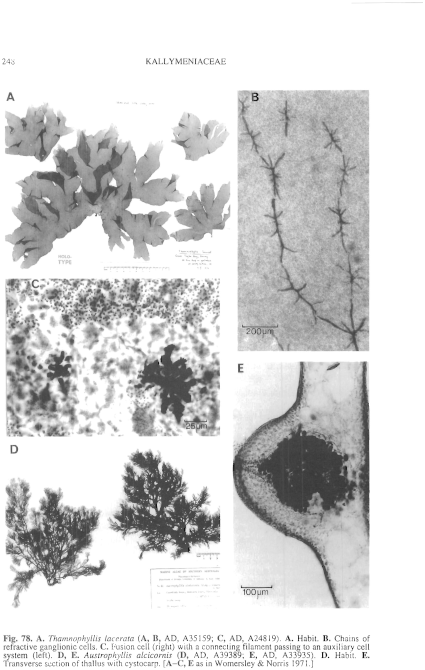|
|
|
|
|
|||||||||||
|
Electronic Flora of South Australia Species Fact Sheet
Phylum Rhodophyta – Class Florideophyceae – Order Gigartinales – Family Kallymeniaceae
Thallus (Fig. 78A) red-brown to dark red, foliose, 5–15 (–20) cm high and 10–25 cm across, usually deeply divided into several irregular parts or lobes 1–5 cm broad, with a smooth to irregularly undulate or ruffled margin, arising from a very short stipe; thallus robust and fairly tough, usually adhering well to paper on drying. Holdfast discoid, 1–3 mm across; epilithic or on shells. Holdfast discoid, 1–3 mm across; epilithic or on shells. Structure. Thallus (Fig. 79A) mostly 200–500 µm thick, consisting of 2–3 layers of small cortical cells grading to a central medulla of irregularly arranged large ovoid cells accompanied by relatively coarse filaments and very prominent darkly staining refractive ganglioid cells; medullary filaments formed from large medullary cells, 5–12 (–15) µm thick, of ovoid to elongate cells, tending to be more densely grouped in the centre of the medulla in older parts of thallus; refractive cells (Fig. 78B) formed in series from the growing apex, frequently connected, with or without a swollen central region and with 6–12 arms, each 8–20 µm thick, irregular in form, and often scarcely tapering along their length (though the arms often basally constricted); outer cortical cells in surface view ovoid to irregular, 3–5 (–7) µm long, ovoid in sectional view of thallus.
Reproduction: Carpogonial branch systems (Fig. 79B) monocarpogonial with an ovoid to clavate supporting cell bearing 10–14 elongate and often once-lobed subsidiary cells some of which may bear a second (and rarely a third) cell; only one carpogonial branch is formed. Fusion cell (Fig. 78C) many-lobed, 120–200 µm across, forming several connecting filaments. Auxiliary cell systems (Figs 78C, 79C) 50–70 µm across, consisting of an ovoid auxiliary cell bearing 6–10 ovoid subsidiary cells, most of which usually cut off a second cell (and rarely a third); rarely a (probably) non-functional carpogonium may occur; connecting filament fusing with an auxiliary cell (Fig. 78C) prior to gonimoblast development. Cystocarps 0.5–1 mm across, scattered, ostiolate, protruding somewhat on one side of the thallus, with spherical to ovoid carposporangia 10–15 µm across intermixed with gonimoblast filaments and medullary cells. Male thalli doubtfully observed; spermatangia apparently cut off from the outer cortical cells.
Tetrasporangial thalli not observed.
Type from Great Taylor Bay, Bruny I., Tas., 10–16 m deep (Shepherd, 7.ii.1970); holotype in AD, A35159. Isotypes distributed to various herbaria.
Selected specimens: Twin Rocks, Head of Great Australian Bight, S. Aust., 20–22m deep (Branden, 19.i.1991; AD, A61144). Egg I., Isles of St Francis, S. Aust., 32–38 m deep (Shepherd, 11.i.1971; AD, A38054). Pearson I., S. Aust., 30 m deep (Shepherd, 10.i.1969; AD, A34048). Elliston Bay, S. Aust., 7 m deep (Shepherd, 21.x.1970; AD, A37553). Investigator Strait, S. Aust., 43 m deep (35° 26' S, 137° 07' E) (Watson, 27.i.1971; AD, A38147). Orontes Bank, Gulf St Vincent, S. Aust., 10m deep (Thomas, 28.iii.1961; AD, A24819). Great Taylor Bay, Bruny I., Tas., 6 m deep (Shepherd, 7.ii.1970; AD, A35536).
Distribution: Head of the Great Australian Bight to Gulf St Vincent, S. Aust., and the east coast of Tasmania.
Taxonomic notes: T. lacerata agrees well structurally with Thamnophyllis but differs from both South African species in being monocarpogonial and in the form of the thallus. The auxiliary cell systems in T. lacerata show well the likely derivation of such systems from carpogonial branch systems by reduction through non-functional carpogonial branches to their absence, but with common retention of second or even third cells on the subsidiary cells. The refractive cell system in T. lacerata is remarkably prominent and permits ready recognition of this species in the sterile state. The series of refractive cells are clearly derived from some of the conspicuous and first-formed medullary cells very close to the growing apex of the branches.
References:
WOMERSLEY, H.B.S. & NORRIS, R.E. (1971). The morphology and taxonomy of Australian Kallymeniaceae (Rhodophyta). Aust. J. Bot. Suppl. 2, pp. 1–62.
The Marine Benthic Flora of Southern Australia Part IIIA complete list of references.
Publication:
Womersley, H.B.S. (14 January, 1994)
The Marine Benthic Flora of Southern Australia
Rhodophyta. Part IIIA, Bangiophyceae and Florideophyceae (to Gigartinales)
Reproduced with permission from The Marine Benthic Flora of Southern Australia Part IIIA 1994, by H.B.S. Womersley. Australian Biological Resources Study, Canberra. Copyright Commonwealth of Australia.
Illustrations in Womersley Part IIIA, 1994: FIGS 78 A–C, 79 A–C.

Figure 78 enlarge
Fig. 78. A. Thamnophyllis lacerata (A, B, AD, A35159; C, AD, A24819). A. Habit. B. Chains of refractive ganglionic cells. C. Fusion cell (right) with a connecting filament passing to an auxiliary cell system (left). D, E. Austrophyllis alcicornis (D, AD, A39389; E, AD, A33935). D. Habit. E. Transverse section of thallus with cystocarp. [A–C, E as in Womersley & Norris 1971.]

Figure 79 enlarge
Fig. 79. A–C. Thamnophyllis lacerata (AD, A35159). A. Transverse section of thallus. B. Carpogonial branch system. C. Auxiliary cell system. D–H. Austrophyllis alcicornis (D–G, AD, A33935; H, AD, A33871). D. Transverse section of thallus with a carpogonial branch system. E. Carpogonial branch system. F. Auxiliary cell system. G. Transverse section of cortex with spermatangia. H. Transverse section of cortex with tetrasporangia. I–K. Austrophyllis harveyana (I, MEL, 1005976; J, K, MEL, 1005977). I. Transverse section of thallus with tetrasporangia. J. Carpogonial branch system. K. Auxiliary cell system. [A–K after Womersley & Norris 1971.]

|
Email Contact: State Herbarium of South Australia |

|